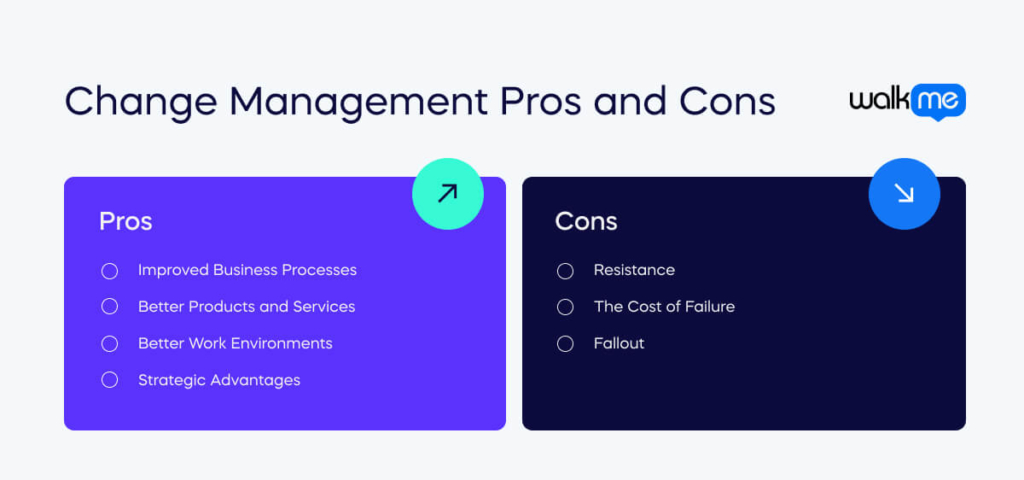Change management has its benefits and drawbacks, like any other business discipline. Below, we’ll explore change management pros and cons.
First, we’ll explore the benefits of change management, such as:
- How it can help businesses grow and thrive in the marketplace
- Its positive impact on employees and the work environment
- Ways it can enhance business operations and processes
Then, we’ll take a look at some change management cons, including:
- The cost of failure
- Consequences of success
- Friction and resistance
Let’s get started.
Change Management Pros and Cons

Organizational change is necessary for many businesses today.
However, it’s not always smooth sailing – and it doesn’t always work properly.
When change management does work, though, its benefits far outweigh the drawbacks.
Benefits of Change Management
Here are a few major benefits of change management:
Improved Business Processes
Organizational change can, of course, take many forms.
A few examples:
- Organizational restructuring – Examples include changing team structures, redistributing personnel, or restructuring hierarchies.
- Process changes – Changing internal business processes can improve productivity, cut costs, and have a number of other positive effects on business operations.
- Digital transformation – Today, digital adoption, digital transformation, and digitalization are commonplace. Technological advancement can help organizations streamline workflows, enhance performance, and become more competitive.
These are just a few examples of how change management can improve business processes.
The results of such transformations – when successful – positively impact an organizations bottom line.
Better Products and Services
Another common reason for organizational change is to improve its products or services.
In some cases, improving products and services does not require organizational transformation.
In others, it does.
For instance, when an organization makes a major shift to its product line, it could require organizational change:
- A coffee shop that begins roasting its own coffee would require new staff, new equipment, and new facilities
- A software company that pivots to a completely different product type may require new experts, new staff, and new processes
- A clothing company that begins producing other accessories or apparel, likewise, may need new facilities, expertise, and equipment
These are just a few examples of how changes to a product offering may require organizational transformation.
And, as with the changes mentioned above, the result could offer big boosts to a company’s bottom line.
Better Work Environments
One of the most frequently reported benefits of change management is an improvement to the work environment.
In a study by Google, this was found to be the biggest benefit by many of the study’s participants. This is particularly interesting, because resistance is one of the largest obstacles to change.
Although the ROI of a better work environment is hard to calculate, benefits include:
- Happier, more productive employees
- Increased retention and loyalty
- A better workplace culture
These benefits, in turn, translate into strategic advantages for the organization.
Strategic Advantages
Ultimately, every organizational change should improve a company’s strategic position.
Regardless of the nature of the change – from digital adoption to restructuring – every change should offer a strategic advantage.
The following changes, for instance, would all be designed to enhance a company’s strategic position:
- New and better software tools
- Improvements to the supply chain
- New product or service offerings
Of course, change itself is a calculated risk – and even if the change is successful, the strategic impact is not certain.
This will be discussed below, in the section on change management cons.
Drawbacks of Organizational Change
There are cons to change management, of course – especially if a program is unsuccessful.
However, even if a program meets its objectives, there may be other drawbacks.
Resistance
Employee resistance is one of the biggest obstacles to change.
This resistance usually stems from fear of change or the fear of the unknown.
In most cases, this resistance comes from frontline employees and middle management.
To tackle this resistance, it is vital to create:
- Effective communication strategies
- A strong vision for change that demonstrates personal value to each employee
- A team of change advocates that spans departments and business areas
Failure to anticipate and plan for resistance usually has very bad consequences.
In many cases, it can cut into a program’s results.
And in worst case scenarios, it can cause a program to fail completely.
The Cost of Failure
Program failure can be traced to many causes, including:
- Poor training, communication, planning, training, and change strategy
- Inability to adapt to changing circumstances
- Lack of executive buy-in
Usually, though, there are multiple causes. Each problem detracts from a program bit by bit, until the change program fails completely.
As you can imagine, failure can have big costs:
- Loss of investment, including time, money, and resources
- Negative impacts to employee confidence and the company culture
- Reversion to the old way of doing things – which means a company has not moved forward
All of these can be very detrimental to the organization in question.
The best way to prevent failure is to create a well-structured, sophisticated change program.
By strategizing, planning, and carefully addressing problems before they arise, you stand a greater chance of succeeding and getting better results.
Fallout
Even when a program does succeed, there can be downsides.
Here are a few hypothetical examples:
- A company completely changes its main product or service – in the process, it loses any teams associated with that product or service
- A cultural change initiative helps a company modernize for the digital age – however, it alienates employees who preferred the old way of operating
- New software speeds up workflows – but automates some jobs out of existence
These are just a few examples of how successful programs can have negative impacts.
Conclusion
Change is inevitable.
As we have seen, change management is not without drawbacks.
However, the benefits of successful change can help an organization grow, thrive, and improve.
To minimize the downsides of change management, make sure you plan properly, strategize effectively, and continually improve.

